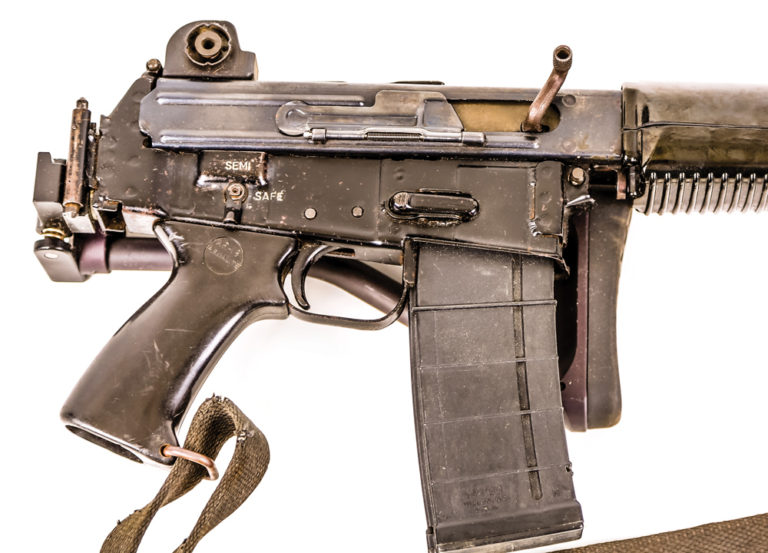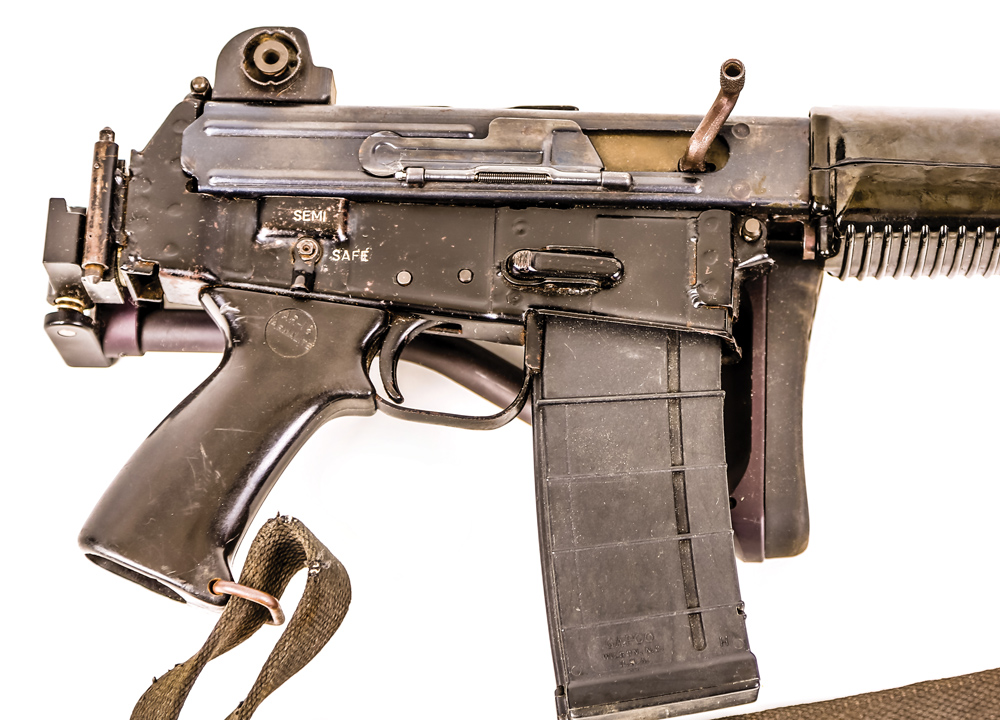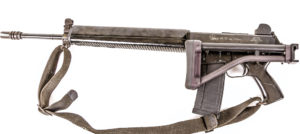

Known for their development of the famed AR-15, Armalite's AR-18 was another important tactical trendsetter in the black rifle space.
Evolution of the AR-18
In the early ’50s, Eugene Stoner worked on the 7.62 x 51mm AR-10 rifle, and after several years of revision, in 1956-57, the rifle was offered up as Armalite’s entry into the U.S. military’s trials to replace the M1 Garand as the standard service rifle. Stoner’s AR-10 went up against the FN FAL (dubbed the T-48 in trials) and the M-14 (dubbed the T-44) in a competition to provide the U.S. with the “rifle of the future.”
The AR-10 was not selected, so ArmaLite licked their wounds and moved on to continue designing cutting-edge firearms using state-of-the art materials (plastics, polymers, titanium and Stellite) when other manufacturers were still dealing in steel and wood.
In 1956, Stoner was also working on a new lightweight rifle, the AR-15, which fired the 5.56mm/.223 round that the U.S. and NATO were exploring. This rifle was eventually adopted by the military, beginning with the U.S. Air Force in 1961, and became the standard military rifle.
At the same time he was working on the AR-15, Stoner collaborated with ArmaLite engineer Arthur Miller on a lightweight, easy to manufacture rifle to be shopped to U.S. allies whose armed forces couldn’t afford the expensive AR-10. The AR-16 was, for all intents and purposes, an experiment. It was made of sheet metal stampings and on machinery that was not expensive and could be operated by indigenous personnel in developing nations.

The rifle was designed to have only a few machined and milled parts, including the barrel, bolt and carrier, and flash hider. Surprisingly, this rifle wasn’t intended to supplant the U.S. military’s M-14 rifles, but rather, it was designed to be a cheap and easy to manufacture rifle to support Asian, African and South American allies in the battle against communism.
Unfortunately, the rifle didn’t really make it past the prototype stage, but the lessons learned in its design and construction would be used in ArmaLite’s next automatic rifle, the AR-18.
The AR-18 was designed and patented after Stoner’s departure from ArmaLite, but it still bore some design elements from his previous AR-10, AR-15 and AR-16 offerings. Arthur Miller, who worked on the AR-16 project with Stoner, along with two other engineers named George Sullivan and Charles Dorchester, began, in 1962, to design a new AR-16.
It would be in a 5.56mm format and easy for unskilled labor to manufacture. Miller and his team took the lessons learned from the AR-16 and put them into practice with the AR-18 design. Again, it was made largely of stamped metal, and the number of forging and machining operations required for manufacture were minimized.
When the rifle debuted in 1964, it was a pretty neat offering—shorter than the AR-15, with an 18-inch barrel instead of the 20-inch AR-15. It also had a clever side-folding stock that made vehicle transport much easier than carrying a full-sized rifle. Unfortunately, by the time it was released, the U.S. was entrenched in the Vietnam Conflict and had little to no desire to adopt the new AR-18, although they did test a few. It didn’t seem like too many other nations wanted the new rifle either.
Production was started in 1967 on the rifle based on some limited orders at the Howa factory in Japan (ArmaLite at the time was more of a design and prototype company, not a manufacturing facility), and even this was problematic. The Japanese government forbade the shipment of weapons to nations actively involved in the war in Southeast Asia. As a result, production was moved to Costa Mesa, Calif.
The AR-18 had a civilian counterpart called the AR-180. This was designed to be a sporting rifle or a police long arm, and was semi-automatic only. It sold marginally well. It seemed that the only enthusiastic users of the AR-18 were those in the Irish Republican Army, which used illegally purchased and stolen ArmaLite rifles in Northern Ireland against the British, and even nicknamed the rifle “The Widowmaker.” In 1980, after roughly 16 years of production in Japan, the U.S. and, later, in Dagenham, England, production ceased.
My First AR-18

At a gun show in February of 2004, I got an almost identical representation of the AR-18/180 that Arnold used in The Terminator. It was even missing the butt stock just like the rifle in the movie. The best part was they were only asking $300 for it.
I bought the rifle and took it home with the intent of quickly getting a new stock from an online vendor. Wrong. Evidently, butt stocks for the AR-180 are made of “un-obtanium.” They were unavailable at any price, so I had my machinist friend make a mounting block to attach to the rear of the sheet metal receiver, and I put an Ace FN-FAL style folder on it. It wasn’t historically accurate, but I could at least fire it from the shoulder.
So by March of 2004, my dream rifle had a stock and could be fired. I took it for a test run. My impressions were that the designers did a lot of things right with the AR-18/180 and quite a bit wrong. It was fairly accurate, as long as I stayed with 55-grain bullets. The 1:12 rifling would turn heavier projectiles into boat-shaped holes in the target.
The trigger was very heavy compared to most AR-15s I’ve fired. Also, the proprietary magazine release and mag-locking cut in the magazine made finding the correct magazine difficult. The AR-15 can use an AR-18 mag, but not vice-versa.
What did they do right? The gas system is very, very good. My rifle has eaten every round I’ve thrown at it. The ergonomics are pretty good, too. Plus the folding stock makes it handy to carry. However, all things considered, I wish the Terminator had chosen a rifle with a better trigger. While I still think my AR-180 is cool, it’s not the go-to gun I imagined it would be after watching that film back in 1984.
I shoot it every once in a while, and my range mates all think it looks cool, but after owning my own ArmaLite AR-180, I came to the inexorable conclusion that I’d have to move on to my second favorite semiautomatic to appear in a film. I saw Robin Williams in this movie called The Survivors, and he had this Valmet M-76—maybe we’ll talk about that next time.
This article appeared in the June 12, 2014 issue of Gun Digest the Magazine.

Next Step: Get your FREE Printable Target Pack
Enhance your shooting precision with our 62 MOA Targets, perfect for rifles and handguns. Crafted in collaboration with Storm Tactical for accuracy and versatility.
Subscribe to the Gun Digest email newsletter and get your downloadable target pack sent straight to your inbox. Stay updated with the latest firearms info in the industry.









Ironically, I happen to have an AR-180 in NIB condition, without the box! When I got it a couple of years ago, it was still covered in cosmoline and it still has some tucked away in some corners I haven’t taken the time to clean. I swabbed out the barrel and fired two rounds into a test fire tube to make sure it functioned. It is a Howa series, one of less than 4,000 made by Howa. Word is that the early “production” guns made at the Costa Mesa plant required a lot of hand-fitting. After 4,018 were produced at the CM plant, the licenses was sold to Howa where 3,927 were manufactured. These are considered to be the best of the ones made, but in order to be lawfully manufactured in Japan, they had to be “de-milled”, i.e. rendered non-military. That was done by making the bayonet lug without the small “ears” which lock the bayonet in place. In 1979, Sterling in the UK was licensed to produce the rifles and 12,362 were made at that plant. These are ones most often found on the market.
I have all the accessories, including an additional aftermarket scope base. That includes the OEM scope, sling, 9 OEM 20rd magazines manuals, etc. The mags are NOT compatible with AR-15 receivers (that includes all variations of the AR platform). AR mags CAN be modified to work with the AR-180, including MAGPUL. Not hard to do. Some OEM/compatible mags including 30 & 40 rd ones are available on the market at a price.
At my age, I am now considering selling off some of my collection. If one is interested, you will find a way to contact me. Be advised, this is a great rifle, but I am NOT giving it away. There just are NOT that many out there and especially in this condition!
https://youtu.be/RsokPP-yQcg